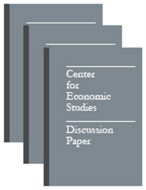Recalculating ... : How Uncertainty in Local Labor Market Definitions Affects Empirical Findings
Recalculating ... : How Uncertainty in Local Labor Market Definitions Affects Empirical Findings
Working Paper Number: CES-17-49
Abstract
This paper evaluates the use of commuting zones as a local labor market definition. We revisit Tolbert and Sizer (1996) and demonstrate the sensitivity of definitions to two features of the methodology: a cluster dissimilarity cutoff, or the count of clusters, and uncertainty in the input data. We show how these features impact empirical estimates using a standard application of commuting zones and an example from related literature. We conclude with advice to researchers on how to demonstrate the robustness of empirical findings to uncertainty in the definition of commuting zones.
Others in Series
Working Paper
A Comparison of Training Modules for Administrative Records Use in Nonresponse Followup Operations: The 2010 Census and the American Community Survey
Working Paper
Estimating the Costs of Covering Dependents through Employer-Sponsored Plans
Working Paper
Taken by Storm: Hurricanes, Migrant Networks, and U.S. Immigration
Page Last Revised - October 8, 2021




